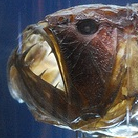Fangtooth is a fish species that belongs to the famous family named Anoplogastridae. These dangerous yet beautiful-looking fishes are commonly found under the tropical and temperate water depths. The usual water depth in which they thrive is approximately 1640 feet to 6562 feet. The genus of their scientific name is derived from two Greek words named “anoplo” and “gaster”. Anoplo means unarmed whereas gaster means stomach. Unarmed does not mean that these fishes appear unarmed because they have very large and sharp teeth. The Fangtooth has a compressed body that is small in size but their heads are large.
Fangtooth Facts
The scientific name of a Fangtooth is Anoplogaster cornuta and Anoplogaster brachycera. They are commonly named ogrefish, common fangtooth, and shorthorn fangtooth. Fangtooth belongs to the order Beryciformes. The basic animal group of Fangtooth is fish. The distinguishing characteristics of these fishes include long and sharp teeth with an extended lower jawline. The size of an Anoplogaster brachycera grows up to 3 inches whereas the size of Anoplogaster cornuta may reach up to 6 inches to 7 inches. They feed on small fishes and crustaceans. Their habitat includes the Atlantic and Indian oceans. They are also found in the Pacific ocean.

Fangtooth Size
The size of the Fangtooth is small. They have a small-sized compressed body that has an elongated and extended lower jawline. Their teeth are sharp and longer than their overall body. These fishes live mostly in deep water and their average size is up to 18 cm long. The fangtooth looks like a monster because of its teeth. They have a maximum length of about 6 inches only. There are a lot of mucous cavities that are present in their mouth. These cavities are present within their skin. Small, Ricky scales are covering the body of these dangerous fishes.
Fangtooth Adaptations
The adaptations of fangtooth fish are quite complicated. They thrive in the deep blue seawater of the Atlantic and Pacific oceans. These fishes grow only up to 18 cm long i.e. 6 inches long. These beautiful yet dangerous fishes are the predators to tuna, merlin, and different other small fishes. These fishes are adaptive to have such strong and long teeth because they are one of the most powerful predators of the midnight sea. Their teeth help them to get a large-sized meal from the sea. The fangtooth fishes get adapted to the environment they live in. They keep on updating their system according to the environment.
Fangtooth Predators
The Fangtooth is a predator fish that belongs to the larger order named Beryciformes. All fishes that belong to this order are carnivorous, which means they feed on other fishes and meat. They especially feed on animals like crustaceans. There isn’t enough data available about these fishes because they are deep-sea dwellers and nocturnal fishes. These fishes are somehow difficult to study. They usually feed on small-sized fish. Sometimes, they also feed on larger squids. Their teeth help them to feed on easily. Scientists believe that these fishes follow the way of “diurnal vertical migration”. In this phenomenon, they come on the surface to feed and then move back to the depth of water.








0 Comments